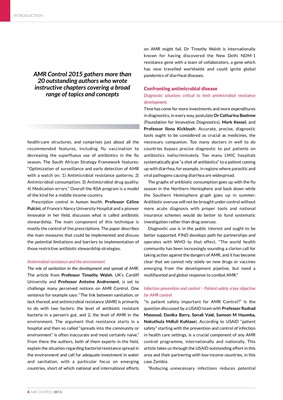
control within health-care structures, and comprises just
about all the recommended features, including flu
vaccination to decreasing the superfluous use of
antibiotics in the flu season. The South African Strategy
Framework features: "Optimization of surveillance and
early detection of AMR with a watch on: 1) Antimicrobial
resistance patterns; 2) Antimicrobial consumption; 3)
Antimicrobial drug quality; 4) Medication errors." Overall
the RSA program is a model of the kind for a middle income
country.
Prescription control in human health. Professor Céline
Pulcini, of France's Nancy University Hospital and a pioneer
innovator in her field, discusses what is called antibiotic
stewardship. The main component of this technique is
mostly the control of the prescriptions. The paper describes
the main measures that could be implemented and discuss
the potential limitations and barriers to implementation of
those restrictive antibiotic stewardship strategies.
Antimirobial resistance and the environment
The role of sanitation in the development and spread of AMR.
The article from Professor Timothy Walsh, UK's Cardiff
University and Professor Antoine Andremont, is set to
challenge many perceived notions on AMR Control. One
sentence for example says: "The link between sanitation, or
lack thereof, and antimicrobial resistance (AMR) is primarily
to do with two factors: the level of antibiotic resistant
bacteria in a person's gut, and 2, the level of AMR in the
environment. The argument that resistance starts in a
hospital and then so called "spreads into the community or
environment" is often inaccurate and most certainly naive."
From there the authors, both of them experts in the field,
explain the situation regarding bacterial resistance spread in
the environment and call for adequate investment in water
and sanitation, with a particular focus on emerging
countries, short of which national and international efforts
on AMR might fail. Dr Timothy Walsh is internationally
known for having discovered the New Delhi NDM-1
resistance gene with a team of collaborators, a gene which
has now travelled worldwide and could ignite global
pandemics of diarrheal diseases.
Confronting antimicrobial disease
Diagnostic solutions critical to limit antimicrobial resistance
development.
Time has come for more investments and more expenditures
in diagnostics, in every way, postulate Dr Catharina Boehme
(Foundation for Innovative Diagnostics), Mark Kessel, and
Professor Ilona Kickbush: Accurate, precise, diagnostic
tools ought to be considered as crucial as medicines, the
necessary companion. Too many doctors in well to do
countries bypass precise diagnostic to put patients on
antibiotics indiscriminately. Too many LMIC hospitals
systematically give "a shot of antibiotics" to a patient coming
up with diarrhea, for example, in regions where parasitic and
viral pathogens causing diarrhea are widespread.
The graphs of antibiotic consumption goes up with the flu
season in the Northern Hemisphere and back down while
the Southern Hemisphere graph goes up in summer.
Antibiotic overuse will not be brought under control without
more acute diagnosis with proper tools and national
insurance schemes would do better to fund systematic
investigation rather than drug overuse.
Diagnostic use is in the public interest and ought to be
better supported. FIND develops path for partnerships and
operates with WHO to that effect. "The world health
community has been increasingly sounding a clarion call for
taking action against the dangers of AMR, and it has become
clear that we cannot rely solely on new drugs or vaccines
emerging from the development pipeline, but need a
multifaceted and global response to combat AMR."
Infection prevention and control - Patient safety a key objective
for AMR control
"Is patient safety important for AMR Control?" Is the
question discussed by a USAID team with Professor Rashad
Massoud, Danika Barry, Sonali Vaid, Samson M Haumba,
Nokuthula Mdluli Kuhlase). According to USAID "patient
safety" starting with the prevention and control of infection
in health care settings, is a crucial component of any AMR
control programme, internationally and nationally. This
article takes us through the USAID outstanding effort in this
area and their partnering with low-income countries, in this
case Zambia.
INTRODUCTION
8 AMR CONTROL 2015
AMR Control 2015 gathers more than
20 outstanding authors who wrote
instructive chapters covering a broad
range of topics and concepts